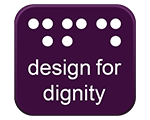Design For Dignity
Retail Guidelines





The research provided shows that people who experience disability highly rate the attitude and disability awareness of customer service staff as a very important or critically important attribute of a good retailer. We also know that these customers are prepared to move their business elsewhere when service is not up-to-scratch or the business is not accessible.
How can businesses consistently deliver a dignified experience for customers who experience disability?
The first step is to ensure that the premises or store is accessible. If a customer cannot get in and around independently, the service experience is not very relevant.
Agree on simple principles or steps that team members can follow that lead to an independent, dignified experience. Some examples of these principles or guidelines are listed below, but it is important that they mesh with your existing service principles.
Training is one aspect of learning and is very important. As the feedback suggests, having staff members who have been taught what to do is very important. Training needs to be current and reinforced.
Ron's story: “A wonderful birthday lunch for mum!”
“Last year I took mum out to lunch on her birthday to a local club. The whole family came as well. I couldn't fault the service. I swear that the waitress had training in disability awareness. She took the family's orders first. This is the way I wanted it because I didn't feel pressured. This gave me more time to work out what I wanted and to type the message into my communication aid. She was patient and gave me time. When it was my turn, I was able to type what I wanted for lunch. She waited patiently. Even when I was typing long words like cappuccino which are harder to spell, she didn't interrupt. I felt great. It was nice to be able to go out for lunch with my family and for things to go smoothly.”

The AND survey-based research tells us that people with disability as customers perceive that this is an important way for the organisation to learn about disability and to drive more acceptance. Retail environments that are built for staff members experiencing disability are more likely to be accessible for customers.
A study by Kalargyrou and Volis (2014)*Kalargyrou, V., Volis, A. A., 2014, Disability inclusion initiatives in the hospitality industry: an exploratory study of industry leaders, Journal of Human Resources in Hospitality & Tourism, Vol. 13, No. 4, pp. 430-454, looks at disability inclusion initiatives in eight hospitality companies. The study lists a number of benefits that hospitality businesses report from proactively integrating people with disability into the workforce, while only two of the eight companies reported challenges. Benefits include: improved innovation, problem-solving abilities, and unique ideas; improved customer satisfaction and customer service capabilities; and establishing a positive company image, improving marketing initiatives, and attending to social sustainability.
Overall, the study reports that integrating people with disability into the workforce improves business performance and business success. Given the high employee turnover ratios frequently experienced by hospitality companies, the authors suggest that findings that workers with disability are loyal, reliable, motivated, productive, and prompt in attendance should influence employers to consider disability inclusion as a way to save money, improve worker consistency, reduce turnover, and ultimately improve the success of the corporation.
The study focuses on companies that have a strong initiative to integrate people with disability in their workforce. Based on the research questions, common themes are identified among the eight hospitality companies surrounding best practices for integrating people with disability into the workforce. Among the findings of the study, it is reported that most of the featured companies suggest that establishing diversity inclusion councils, teams, foundations, or task forces is important to the proactive recruiting, hiring, and supporting of employees with disability. The companies have also created alliances or partnerships with social service and vocational rehabilitation agencies and other organisations involved in raising awareness about people with disability as a way to identify and recruit candidates for employment. To help integrate people with disability into the workforce, most companies also provide education and training to employees without disability to include working and interacting with employees with disability.
‘Service’ architecture extends beyond who is in the team and how team members behave with customers. There are many small features that can be used to assist in delivering and reminding staff of their responsibility to customers with disability:

Scope Australia assisted the National Disability Insurance Agency*http://www.scopeaust.org.au/how-can-i-communicate-at-the-national-disability-insurance-scheme-ndis/
Viewed September 2016 to develop a series of communication boards that assist people with communication difficulties to get their message across. The boards use symbols or words to convey pre-selected messages so that visitors to any NDIS office can communicate in a dignified way. Communication boards can be tailored to suit a business, and ensure that customers with different abilities have equitable access to products and services in retail settings.